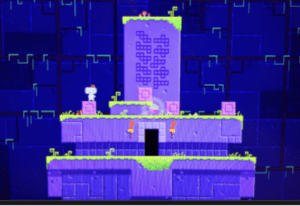For this week’s critical play, I will be analyzing the game Fez. It was developed in 2012 by an indie game designer, Phil Fish. It can be played on various platforms including PC, Nintendo Switch and PlayStation. I played this game on my PC. The target audience of the game is 8+ years. Fez has a unique gameplay mechanic based on changing perspective at will. The mind blowing design level and the mesmerizing pixel art of the game make it no shock that it took 5 years for Phil Fish to develop the game. It’s a visual game meant to encourage exploration in the player. The game focuses on a universe meant to be discovered and understood.
The game has players control the protagonist Gomez who comes into possession of a magical Fez that allows him to shift his perception of the world into 3D from his old 2D world perspective. It allows the player to shift dimensions, however, at any given time 75% of the dimension is hidden from view. Gomez then using this newfound ability sets off to collect pieces of a magical cube in hopes to return the world back to normalcy. In order to capture those pieces, Gomez needs to solve puzzles and complete levels. The entire game consists of challenges that seem to build off each other. Although the game attempts to create some narrative fun with this plot, in my opinion, the story itself is weak and only serves the purpose to explain the mechanics of the puzzle-oriented game to the player.
The core game mechanic of the game involves rotating the 3D world by 90 degrees to explore different sides of the world. At first it seems as though the main objective of the game is only to rotate the view and jump from one place to another. However, as I explored more I found out that it had clues hidden everywhere throughout the game. There was a logic behind seemingly random details of the world. The more one invests into the game, the more it gives back to the user. Every environment has a hidden puzzle to solve and the game never tells you directly how to solve it. There are unknown symbols scattered throughout the world seemingly unimportant but actually meant to be decoded by the user using pure logic. Once you learn the language of the symbols you start to understand more of the puzzles that you couldn’t figure out before. The game reveals its secrets in such a natural way that the player feels smart once he figures it out.

The picture above shows a few of the symbols that the player is required to decode by pure logic to solve the puzzles.


